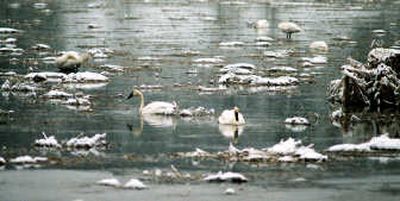Tourism officials hope swans bring visitors

USK, Wash. – Hundreds of tundra swans foraged on open water in southern Pend Oreille County on Wednesday on their annual migration to nest on the marshy expanse of western Alaska.
Their arrival each year is so predictable that tourism officials hope to promote them as a draw for wildlife viewing.
On Wednesday, the Kalispel Tribe of Indians and Pend Oreille River Tourism Alliance hosted a swan tour and celebration of the migration.
A spring snowstorm didn’t prevent the organizations from showing a busload of guests the wonder of the squawking but graceful birds that are appearing in huge groups now at Calispell Lake.
“The idea is to make people aware of what we have up here for natural resources,” said Loyce Akers, of Oldtown, Idaho, which is adjacent to the Pend Oreille County seat, Newport.
Bird-watching is one of Washington’s most popular outdoor activities, especially among older adults, said Susan Harris of the tourism alliance.
Pend Oreille County has an abundance of wildlife, including 267 species of birds, but that bounty “hasn’t been exposed to the outside world,” she said. Her organization and local officials hope to get the word out to enhance the tourism industry and create more jobs for residents.
The tundra swan migration peaks at the end of March each year when thousands of 10- to 22-pound birds can be seen on the lake and at other local waterways – usually at a distance.
“If they are at their peak there are probably three or four thousand swans out there,” said Washington state wildlife biologist Steve Zender.
Snow still covers the ground and much of the local waters remain encased in snow and ice. But it’s spring, and time for the swans to move northward. Because of the snowy conditions, it is not clear whether the swans will hang around longer than normal. Zender said one study in the early 1980s indicated that the migration peaks at Calispell Lake on March 27 or 28. In a typical year, the numbers start to dwindle by the first of April. Regardless, the swans looked to be right at home. They were standing or floating in shallow water and using their long necks to grab aquatic plants or other food hiding underwater.
In addition to Calispell Lake, the swans are usually seen in any number of marshy areas in the region.
Turnbull National Wildlife Refuge south of Cheney, the Colville River Valley near Chewelah and Swanson Lakes Wildlife Refuge south of Creston are other good places to look for them. On Wednesday, a pair of swans was feeding along U.S. Highway 2 north of Bear Lake in Spokane County, and a larger group was foraging along state Highway 211 a few miles north of Highway 2.
But the largest numbers are typically seen at Calispell Lake, probably because it covers low-lying fields and marshy areas this time of year.
During the fall, the migration occurs farther to the west, said swan expert Martha Jordan.
Zender said that in addition to swans, the Usk and Cusick area is a great place to view other bird life, including ducks, herons and eagles. He recommended driving along the county road between Usk and Cusick on the west bank of the Pend Oreille River to see those species.
In addition, an organization affiliated with local chambers of commerce is promoting a scenic loop route in the Selkirk Mountains region of Washington, Idaho and southeast British Columbia. They are on the Web at selkirkloop.org.
The Pend Oreille tourism alliance is on the Web at porta-us.com.